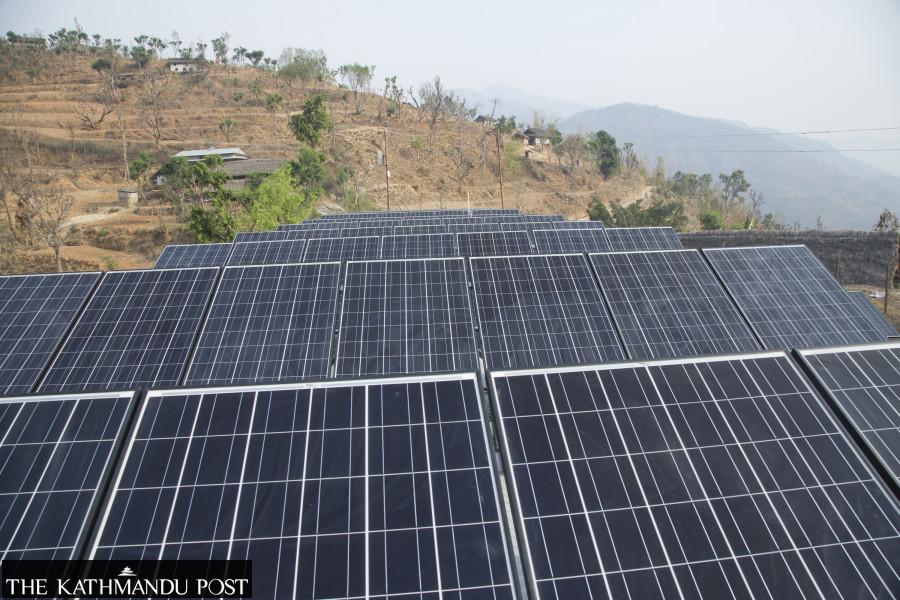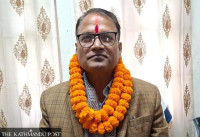National
NEA lowers purchase price of solar electricity
The power utility says it cannot pay more than Rs5.94 per unit. Solar companies say move will discourage new investors.
Prithvi Man Shrestha
The Nepal Electricity Authority has decided to reduce the maximum purchase price for electricity generated by solar plants as the state-owned power utility prepares to procure solar energy through competitive bidding.
The power utility body has decided to pay a maximum of Rs5.94 per unit for solar-generated electricity.
For the last three years, the authority has been paying Rs7.30 per unit for three years as provisioned in the Working Procedures on Grid-Connected Alternative Electric Energy Development-2017.
“A recent board meeting decided to pay a maximum of Rs5.94 per unit to solar plants willing to sell electricity to us,” said Suresh Bhattarai, spokesperson for the Nepal Electricity Authority (NEA). “We have proposed the new rate to the Electricity Regulatory Commission for approval.”
The commission is responsible for fixing the purchase price of electricity or power purchase agreement (PPA) rate for the power sold to the NEA by private sector producers.
Bhattarai said that the NEA would not pay more than what its board has approved for the electricity produced by private sector solar farms.
“There will be competition among solar power producers at prices below the maximum rate,” he added.
However, the commission is unlikely to take decision on the matter immediately for lack of officer bearers. After the removal of its three office bearers recently over their alleged failure to perform their duties, the commission currently has no office bearers.
Last week, the government announced vacancies for these vacant posts.
“I am not aware of the price recommendation of the NEA. If the NEA has recommended the maximum PPA rate for solar-generated electricity, a decision on the matter will be made after office bearers are appointed,” said Gokarna Raj Pantha, secretary at the commission.
In late January, the NEA’s board had decided to procure solar energy only through competitive bidding by ending the fixed rate regime of the last three years maintained as per the decision taken on June 10, 2018. The board in January had also decided that it would set a new maximum price per unit for solar energy.
Meanwhile, the new price per unit proposed by the NEA has left the solar power developers unimpressed.
“The reduction in the maximum rate to be offered to solar developers will affect those who have already invested heavily in the hope of selling their electricity at the existing Rs7.30 per unit,” said Prakash Bikram Basnet, president of Solar Electric Manufacturers Association Nepal.
According to him, the association had requested the NEA to keep the maximum rate at Rs6.8 per unit.
“But the rate proposed by the NEA is far lower than what we had proposed. We will discuss the issue among our members and draw the attention of the government to our concerns,” said Basnet.
He said that the proposed maximum PPA rate could discourage potential and new investors in the solar power sector as setting up solar farms has become difficult due to high land costs and soaring solar panel prices.
The NEA, however, maintains that it decided to implement a competitive pricing mechanism considering decreasing prices of solar energy internationally.
In November 2020, solar energy prices in India hit a record low of INR2 per unit under competitive bidding.
Bhattarai, the NEA spokesperson, said competitive bidding would help discover actual market price of solar energy besides contributing to decreasing the price.
“It is not that solar plants here would be able to sell electricity at the rate as cheap as that in India but a competitive bidding would help to lower the prices for the NEA,” said Bhattarai.
Another reason, according to the NEA, is that it is in no position to procure energy from all solar manufacturers who have applied for PPA.
“We have received applications for PPA for more than 300MW in total,” NEA’s Managing Director Kul Man Ghising told the Post in January.
According to the Ministry of Energy, Water Resources and Irrigation, the power utility body has already signed PPAs with 21 solar energy producers for a total of 110MW. As much as 21 MW of electricity has already been connected to the national grid, the ministry said in a statement in January.
The government has a strategy of maintaining the contribution of solar energy at 10 percent of the total energy under the concept of Generation Mix.




 12.12°C Kathmandu
12.12°C Kathmandu















